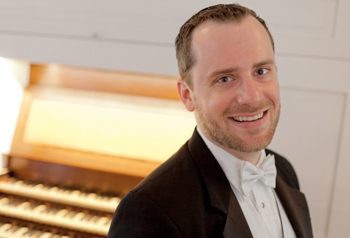by Timothy Robson

This was a homecoming of sorts for Ryan, who is now based in Greenwich, CT, and who studied with Todd Wilson at the Cleveland Institute of Music in the early 2000s.
Clavier-Übung III is sometimes referred to as the “German Organ Mass,” with its settings of chorale melodies for the parts of the Lutheran Mass and Catechism. Members of the Trinity Chamber Singers set the musical context by singing the corresponding hymns for each chorale. The work contains two complete sets of chorale preludes. Jonathan Ryan played the opening prelude, the large chorale settings with pedal, and the closing fugue.
The opening Prelude in E-flat Major is a hybrid of French overture, with its sharply dotted rhythms, and Italian ritornello, segments of music that return to delineate larger sections. Ryan took the middle ground in his interpretation. His playing was more legato than some, the dotted-rhythm passages were smoothed out, and his tempo was conservative and sensible. His phrasing was flexible, his ornamentation modest and sensitive.
The chorale preludes begin with settings of the Kyrie – Christe – Kyrie chorales derived from Gregorian chant. Bach sets them in Motet style, with the tunes migrating from soprano to tenor, and then to the pedals for the majestic full-organ final Kyrie. Particularly striking was Ryan’s stretching of Bach’s chromaticism at the end.
The succeeding preludes become ever more complex and mystical in their contrapuntal techniques and numerological symbolism. The Allein Gott in der Höh (Gloria) is a trio with a voice in each hand and pedal. The prelude depicting the Ten Commandments (Dies sind die heil’gen zehn Gebot) states the tune in a canon ten times.
The technically difficult Vater Unser (Lord’s Prayer) is perhaps the most challenging of the set, with its halting Lombard rhythm (a short, accented note followed by a longer one). The harmonies are chromatic and modernist, and Ryan managed to keep it all clear, with a stately, controlled tempo.
The chorale about Baptism (Christ unser Herr zum Jordan Kam) was registered in a French style, with buzzy reed stops and a constant stream of 16th notes in the manuals over the melody in the pedals. Although the registration was imaginative, the chorale melody was mostly covered by the manual accompaniment.
Aus tiefer Not schrei ich zu dir (“Out of the depths I cry to you”) was perhaps the highlight of this recital. The prelude, on full organ, is in six voices, with four in the manuals and two in the pedals. Bach’s counterpoint is almost beyond mortal comprehension. Ryan’s tempo was very slow, stretching this cry for mercy to its limit, and the wash of organ sound and his command of the work were thrilling.
The final Fugue is an appropriate culmination to this monumental compositional and performance endeavor. Though Bach marks the fugue a organo pleno (with full organ), Ryan ignored that instruction and started with a less substantial opening registration, making a more dramatic conclusion possible.
Published on ClevelandClassical.com March 28, 2017.
Click here for a printable copy of this article



